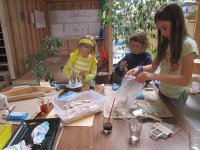Expert Advice: Make More Time for Play
Your content has been saved!
Go to My Saved Content.John Seely Brown, renowned scientist, insightful writer, and all-around big thinker, is serious about play. Playful, adventuresome experiences that engage both mind and body are how we learn best, he told a rapt audience at the recent Powerful Learning Practice Live conference in Philadelphia.
Forget the old-school model of textbooks and tests. His preferred metaphor for learning in today's fast-changing world is whitewater kayaking. It's all about being in the moment, thinking and doing simultaneously, "in constant engagement with the context," he says.
Brown is the former chief scientist of Xerox Corporation and director of its Palo Alto Research Center (PARC). He is currently a visiting scholar at University of Southern California and co-chair of the Deloitte Center for Edge. He also is the author of A New Culture of Learning: Cultivating the Imagination for a World of Constant Change.
"JSB," as he's widely known, doesn't have to look far to find examples of active learners. Surfers, skateboarders, and gamers all exhibit qualities of motivated learners who aren't afraid to take risks, learn from failure, and learn from each other. "Makers" and hackers, meanwhile, unleash their creativity and problem-solving strategies in tinkering studios and hackerspaces. Then there are those who learn in networked spaces, such as the millions of young writers publishing original work on sites like FanFiction. They exemplify another maxim of today's connected learners, which JSB sums up as, "We participate, therefore we are."
The big challenge facing education today, it seems, isn't figuring out how we learn. It's having the courage to "make learning a constant adventure," says JSB. "Montessori and Dewey were 75 years ahead of their time," he adds, in advocating learning by doing. "Maybe, just maybe, their ideas can scale now."
New Spaces for Makers
After listening to JSB, I thought about some recent developments that suggest, just maybe, play is staging a comeback in school.
Consider this: With federal funding, the MENTOR Makerspace program aims to open 1,000 Makerspaces in schools across the country during the next four years. The first 10 spaces just opened in Northern California high schools. Karen Cator, director of the Office of Educational Technology, was there for the kick-off, signaling the Department of Education's desire to boost student interest in STEM fields.
The MENTOR Makerspace model is being developed by the producers of Make Magazine and Maker Faireevents, along with Otherlab, a developer of hardware and software design tools. Funding is coming from DARPA, the federal defense agency that develops military technologies.
Here's how Edsurge describes these new spaces for hands-on, self-directed learning: "Now found in libraries, museums, community centers, and schools, Makerspaces can give students access to tools, materials, and expertise for developing creative projects that offer hands-on learning and real-world STEM applications."
What would a Makerspace bring to your school? "It's a place where you get to do things," Dale Dougherty, founder of Make Magazine and creator of Maker Faire, told Co.Exist,"I think it's sort of a mashup of a shop class, a computer lab, an art class, and maybe a bio lab." In the Makerspace tradition, tangible products emerge through trial, error, collaboration, mentoring, and hefty doses of self-direction. Whimsy is not out of place in Makerspaces, although projects often focus on addressing serious, real-world problems.
Some schools, in advance of this new initiative, have already carved out their own versions of Makerspaces. When I was doing field research for Bringing Innovation to School , I visited the Design/Build studio at St. Gregory School in Tucson, Ariz., and watched students puzzle their way through questions about everything from electronics to bike mechanics. (Watch this video about a student designing a giant trike:
At Monticello High School in Charlottesville, Virginia, a space in the school media center has been converted to a digital production studio where students follow their creative passions. (Hear teacher David Glover explain the thinking behind the studio in this video.)
Meanwhile, YOUMedia centers are sprouting in libraries, museums, and community centers, creating yet more spaces for teens to create using digital media. Here's how YOUMedia describes its research-based model: "YOUMedia's core philosophy is that youth are best engaged when they're following their passions, collaborating with others, and being makers and doers, not passive consumers."
Finally, some teachers are exploring 20-percent projects, named for the Google tradition of giving employees one day a week to pursue their own interests. (It's no coincidence that Google co-founders Sergey Brin and Larry Page both attended Montessori schools, JSB says.) In the classroom, 20-percent projects mean dedicated time for students to chart their course as learners. High school English teacher Al Juliani wrote a widely circulated post about the approach earlier this year.
Is your school making more room for playful learning? How are students responding? Please share your experiences in the comments.
